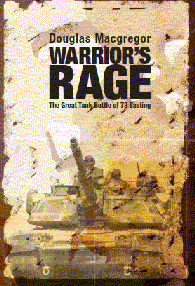 |
ABOUT THE BOOKExperts warned Americans in
1991 that U.S. forces would suffer heavy casualties at the hands of
Iraqi forces who allegedly knew how to hold ground from years of
fighting Iranians. But the "experts"
were wrong.
Late in the afternoon of 26 February 1991, the lead
cavalry troops of "Cougar Squadron," the 2nd Squadron
of the 2nd
Armored Cavalry Regiment, charged out of a sandstorm and caught Iraq's
Republican Guard Corps in the open desert along the North-South grid
line of a military map referred to as the "73 Easting."
Taken by surprise, the defending Iraqi armor brigade was rapidly
swept away in salvos of American tank and missile fire in what became
the largest tank battle
in the history of the U.S. Army since World War II. Metal smashed against metal as round after round
slammed into Iraqi Russian-made
T-72 tanks and armored fighting vehicles.
A few hours later, the few surviving Republican Guards
huddled as prisoners of war while their wounded, lying nearby on the
desert floor received medical attention in the cold night air from
Americans who had just defeated them. The Battle
of 73 Easting did
not secure victory for the American people. Instead of exploiting a
successful attack-an attack with almost no U.S. losses-the U.S.
senior officers in command ordered Cougar Squadron to halt, to
break contact with the enemy, and withdraw behind a meaningless limit of
advance. Cougar Squadron did not withdraw. It
stayed and fought. But contact broken, the Republican Guard's main body escaped, ensuring that Saddam Hussein's regime would survive
and America's war with Iraq would drag on. Warrior's
Rage. The Great Tank Battle of 73 Easting plunges the reader into the fight and its aftermath,
explaining how a victory won
decisively by soldiers on the battlefield, was lost by a U.S. Army chain of
command remote from the fighting; one that never appreciated the power
of its own armored force or the enemy's weakness. Warrior's Rage also asks how much American blood and valor must be
sacrificed again before the civilians--who are supposed to be in
charge--demand the same excellence from America's generals that they
get from their soldiers? As
Americans contemplate current and future combat operations in Iraq and
Afghanistan; this question is no less urgent now than it was in 1991.
|